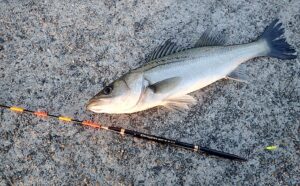Akame; Barramundi in Japan?
Firstly, please take a look at this photo.
This fish may remind some of you of one famous game fish, Nile perch or Barramundi. But apparently, the clothing this man is wearing does not fit the idea of the Nile river or the tropical climate, though the fish looks quite similar.
This fish is called Akame, in Japan. Literal meaning of Akame is the red eyes. This fish is one of the trophy species in Japan, and many lure anglers are dreaming of it.
In this article, let us explore this fish, and some information about the tackles you need to bring, in your next trip to Japan to catch Akame.
Species
Akame, Japanese lates (Lates japonicus) is under the Latidae family and the Lates genus, with Nile perch and Barramundi. Their characteristics are quite close, the silver shiny body color with whitish belly and the large mouth with longer lip on lower jaw.
Differences between these brother species are as following.
| Akame | Barramundi | Nile Perch | |
| Size range for angling | 60 - 130 cm | 60 - 120 cm | 100 - 140 cm |
| Maximum size caught by anglers | 138 cm, 39 kg(link) | 134 cm, 44 kg(link) | 104 kg(link) |
| Physical characteristics and differences | - Red eyes - Silvery body - Higher body than other two compared to length. | - Dark eyes - Silvery body - Slimmer shape | - Dark black eyes - Silver body with some blue marks |
| Water | Saltwater, brackish water(Spawns only in the saltwater.) | Saltwater, brackish water (Spawns only in the saltwater.) | Freshwater, brackish water(Spawns only in the freshwater) |
| Preferred water temperature | 15 - 24 degrees celsius | 26 - 30 degrees celsius | 22 - 28 degrees celsius |
| Feeding style | Bottom feeder | Active in all range | Active in all range |
| Behavior characteristics | Predate during nightVery cautious | Active day and nightAggressive | Active day and nightAggressive |
Since Akame and Barramundi share quite a lot of characteristics, they were labeled as one species, until the academic paper of 1984.
These images, taken from this paper, are describing the difference.
Though the physical characteristics between Akame and Barramundi are quite similar, I doubt that a good Barramundi angler can catch Akame in the same way he does in his home country.
Akame is a very cautious or shy fish, and said to feed only at night. It eats fish species, crustaceans, and polychaetes (such as ragworms), depending on their living environments. Interestingly, it is more selective in their food, than other brother species. In the aquarium, it is hard to assimilate to the artificial bait, and to keep it well people have to supply it with live bait. From its behavioral character, it seems natural for Akame to have such a selective preference on their food.
In Japan, it lives in the southern coasts of western regions, where the warm current, Kuroshio current, is hitting.The most famous areas for Akame angling are Kochi and Miyazaki.
In Kochi, these places are well known for Akame. Urado bay, Shimanto river, and Uranouchi bay.
The life cycle of this fish is not entirely clear yet. It is said that the spawning season is summer and they lay eggs in the sea, somewhere. And the baby fish are living in the weeded area near the river mouth. They are often seen in the area with the sea weed, especially Japanese eelgrass (Zoestera japonica). The young fish wears the completely different pattern in its body color, and it appears that this fish evolved to fit the environment with this seaweed.
Lure fishing for Akame
The tackle for Akame fishing is quite similar to the one for Barramundi, in terms of required strength or heaviness. One of the differences is the length of the rod. The basic setup can be like this.
- Bait casting rod 7 to 8 ft (for casting distance)
- Bait casting reel to fit minimum 100 m of braided line 3 gou to 5 gou (0.30 to 0.40 mm)
- Leader 20 gou to 30 gou(0.70 to 0.90 mm thickness)
(for the gou unit, please refer to this article.)
The popular selection of lures is the minnows and swim baits of 100 to 130 mm.
Below is the photo of an angler for targeting Akame.
Since anglers are wading or fishing from the shore on the river mouth, the searching depth is relatively shallow. And main selections are sea bass lures which dive down to 1 - 3 meters, and swimbaits to search sub surface. Some people are attaching the lead plate on the belly of the swimbait to sink deeper. When people fish in the deeper area, their selection includes vibrations and metal vibrations. Looking at this selection, the way to select the lure is quite similar to the case of Barramundi.
Conservation
The last information is that Akame is listed as an endangered species, and we need to take actions to conserve it. This species is living only in the limited areas, and naturally its population is small. In addition to this condition, the living environments have less and less areas with Japanese eelgrass. It made the environment harsher for this species to reproduce.
Miyazaki prefecture had decided to ban the angling of Akame, as a prefectural legislation. While Kochi has a lot of angling visitors, it is allowed to fish there. We need to pay attention to the fact and think about the contribution we must make to keep this game sustainable.

